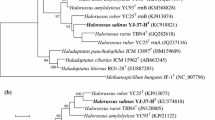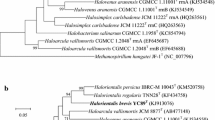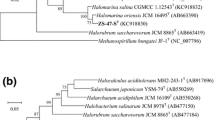Abstract
Halophilic archaeal strain YC25T was isolated from Yuncheng salt lake in Shanxi, China. Cells of strain YC25T were observed to be pleomorphic rods, stained Gram-negative, and formed red-pigmented colonies on solid media. Strain YC25T was found to be able to grow at 25–50 °C (optimum 37 °C), at 1.4–4.8 M NaCl (optimum 1.7 M), at 0–1.0 M MgCl2 (optimum 0.01 M), and at pH 5.5–9.0 (optimum pH 6.5). The cells lysed in distilled water, and the minimal NaCl concentration to prevent cell lysis was found to be 8 % (w/v). The major polar lipids of the strain were phosphatidylglycerol (PG), phosphatidylglycerol phosphate methyl ester (PGP-Me), phosphatidylglycerol sulfate (PGS), sulfated galactosyl mannosyl glucosyl diether (S-TGD-1), sulfated mannosyl glucosyl diether (S-DGD-1), galactosyl mannosyl glucosyl diether (TGD-1), mannosyl glucosyl diether (DGD-1), and an unknown diglycosyl diether (DGD-2) chromatographically identical to those of Halorussus rarus CGMCC 1.10122T. The 16S rRNA gene and rpoB′ gene of strain YC25T were phylogenetically related to the corresponding genes of Halorussus rarus CGMCC 1.10122T (94.3–95.4 and 91.5 % nucleotide identity, respectively). The DNA G+C content of strain YC25T was determined to be 63.3 mol%. The phenotypic, chemotaxonomic, and phylogenetic properties suggested that strain YC25T (=CGMCC 1.12122T = JCM 18363T) represents a new species of Halorussus, for which the name Halorussus ruber sp. nov. is proposed.

Similar content being viewed by others
References
Amoozegar MA, Makhdoumi-Kakhki A, Mehrshad M, Fazeli SAS, Spröer C, Ventosa A (2014) Halorientalis persicus sp. nov., an extremely halophilic archaeon isolated from a salt lake and emended description of the genus Halorientalis. Int J Syst Evol Microbiol 64:940–944
Corral P, Gutiérrez MC, Castillo AM, Domínguez M, Lopalco P, Corcelli A, Ventosa A (2013) Natronococcus roseus sp. nov., a haloalkaliphilic archaeon from a hypersaline lake. Int J Syst Evol Microbiol 63:104–108
Cui H-L, Zhou P-J, Oren A, Liu S-J (2009) Intraspecific polymorphism of 16S rRNA genes in two halophilic archaeal genera, Haloarcula and Halomicrobium. Extremophiles 13:31–37
Cui H-L, Gao X, Yang X, Xu X-W (2010) Halorussus rarus gen. nov., sp. nov., a new member of the family Halobacteriaceae isolated from a marine solar saltern. Extremophiles 14:493–499
Cui H-L, Yang X, Mou Y-Z (2011) Salinarchaeum laminariae gen. nov., sp. nov.: a new member of the family Halobacteriaceae isolated from salted brown alga Laminaria. Extremophiles 15:625–631
Marmur J, Doty P (1962) Determination of the base composition of deoxyribonucleic acid from its thermal denaturation temperature. J Mol Biol 5:109–118
Meier-Kolthoff JP, Göker M, Spröer C, Klenk H-P (2013) When should a DDH experiment be mandatory in microbial taxonomy? Arch Microbiol 195:413–418
Minegishi H, Kamekura M, Itoh T, Echigo A, Usami R, Hashimoto T (2010) Further refinement of Halobacteriaceae phylogeny based on the full-length RNA polymerase subunit B’ (rpoB′) gene. Int J Syst Evol Microbiol 60:2398–2408
Oren A (2012) Taxonomy of the family Halobacteriaceae: a paradigm for changing concepts in prokaryote systematics. Int J Syst Evol Microbiol 62:263–271
Oren A (2014) Taxonomy of halophilic archaea: current status and future challenges. Extremophiles 18:825–834
Oren A, Ventosa A, Grant WD (1997) Proposed minimal standards for description of new taxa in the order Halobacteriales. Int J Syst Bacteriol 47:233–238
Pagaling E, Wang H, Venables M, Wallace A, Grant WD, Cowan DA, Jones BE, Ma Y, Ventosa A, Heaphy S (2009) Microbial biogeography of six salt lakes in Inner Mongolia, China, and a salt lake in Argentina. Appl Environ Microbiol 75:5750–5760
Parte AC (2014) LPSN—list of prokaryotic names with standing in nomenclature. Nucleic Acids Res 42:D613–D616
Qiu X-X, Mou Y-Z, Zhao M-L, Zhang W-J, Han D, Ren M, Cui H-L (2013a) Halobellus inordinatus sp. nov., from a marine solar saltern and an inland salt lake of China. Int J Syst Evol Microbiol 63:3975–3980
Qiu X-X, Zhao M-L, Han D, Zhang W-J, Cui H-L (2013b) Halorubrum rubrum sp. nov., an extremely halophilic archaeon from a Chinese salt lake. Antonie Van Leeuwenhoek 104:885–891
Tamura K, Peterson D, Peterson N, Stecher G, Nei M, Kumar S (2011) MEGA5: molecular evolutionary genetics analysis using maximum likelihood, evolutionary distance, and maximum parsimony methods. Mol Biol Evol 28:2731–2739
Youssef NH, Ashlock-Savage KN, Elshahed MS (2012) Phylogenetic diversities and community structure of members of the extremely halophilic archaea (Order Halobacteriales) in multiple saline sediment habitats. Appl Environ Microbiol 78:1332–1344
Zhang W-J, Han D, Qiu X-X, Zhao M-L, Mou Y-Z, Cui H-L, Li Z-R (2013) Halobellus rarus sp. nov., a halophilic archaeon from an inland salt lake of China. Antonie Van Leeuwenhoek 104:377–384
Acknowledgments
This work was supported by the National Natural Science Foundation of China (No. 31370054), the grant from China Ocean Mineral Resources R&D Association (COMRA) Special Foundation (DY125-15-R-03), and the Qinglan Project of Jiangsu Province and a project funded by the Priority Academic Program Development of Jiangsu Higher Education Institutions (PAPD).
Author information
Authors and Affiliations
Corresponding authors
Additional information
Communicated by Erko Stackebrandt.
Phase-contrast micrograph of strain YC25T, thin-layer chromatograms of the polar lipids extracted from strain YC25T and some related haloarchaea, maximum-parsimony and neighbor-joining phylogenetic tree reconstructions based on 16S rRNA gene and rpoB′ gene sequences showing the relationships between strain YC25T and related members within the family Halobacteriaceae are available as supplementary materials.
Electronic supplementary material
Below is the link to the electronic supplementary material.
Rights and permissions
About this article
Cite this article
Xu, WD., Zhang, WJ., Han, D. et al. Halorussus ruber sp. nov., isolated from an inland salt lake of China. Arch Microbiol 197, 91–95 (2015). https://doi.org/10.1007/s00203-014-1058-z
Received:
Revised:
Accepted:
Published:
Issue Date:
DOI: https://doi.org/10.1007/s00203-014-1058-z




